Opening Surveys
Grivas: Sicilian B33
1.e4 c5 2.Nf3 Nc6 3.d4 cxd4 4.Nxd4 Qb6 5.Nb3 Nf6 6.Nc3 e6 7.Bd3 d6 8.0-0 a6 9.a4 Qc7
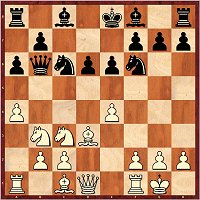 |
|
In the Hermes Variation (9.a4) the spread of the queenside by
means of ...b5 is prevented, but this does not profit White to any
great extent because compared to the Scheveningen System the Nb3 is badly placed and a kingside attack achieves nothing. |
Postny: Sicilian B48
1.e4 c5 2.Nf3 e6 3.d4 cxd4 4.Nxd4 Nc6 5.Sc3 Qc7 6.Be3 a6 7.Qd2 Nf6 8.0-0-0 Bb4 9.f3 Ne5 10.Nb3 b5 11.Qe1
|
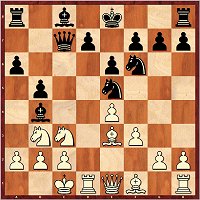
|
|
While winning his title, new European champion Vladimir Potkin
won a very nice game against the extremely up-to-date setup with
11.Qe1,
but nevertheless Evgeny Postny has discovered an advantage for
White. But he also presents a good alternative for Black.
|
Moskalenko: French C01
1.e4 e6 2.d4 d5 3.exd5 exd5
 |
|
Viktor Moskalenko is an enthusiast of the French Defence and so
it comes as no surprise that he is also unafraid of the Exchange
Variation. In his article the grandmaster introduces several plans
for Black. |
Dembo: Evans Gambit C51
1.e4 e5 2.Nf3 Nc6 3.Bc4 Bc5 4.b4 Bxb4 5.c3 Be7
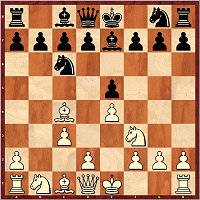 |
|
Inspired by Jan Gustafssons DVD “Open games” Yelena Dembo offers
in her contribution a complete repertoire against the Evans
Gambit. According to her investigations, Black has at least a level
game in all lines. |
Kritz: Two Knights Defence C58
1.e4 e5 2.Nf3 Nc6 3.Bc4 Nf6 4.Ng5 d5 5.exd5 Na5 6.Bb5+ c6 7.dxc6 bxc6 8.Bd3
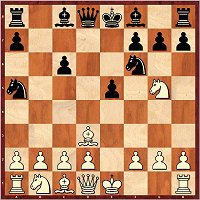 |
|
After 8.Bd3
White has the option, if needed, to go with his knight from g5
to e4. Kritz analyses five different replies, but none of them is
completely satisfactory for Black. |
Breutigam: Ruy Lopez C68
1.e4 e5 2.Nf3 Nc6 3.Bb5 a6 4.Bxc6 dxc6 5.0-0 Bg4 6.h3 Bh5 7.g4 Bg6 8.Nxe5 Qh4 9.Qf3 f6 10.Nxg6 hxg6
 |
|
With 6...Bh5
(instead of the usual 6...h5) Black offers a pawn sacrifice,
which White should accept if he wants to play for an advantage.
After it we soon end up in the position in the diagram, which
promises Black interesting play. |
Kuzmin: Anti-Slav D23
1.d4 d5 2.c4 c6 3.Nf3 Nf6 4.Qc2 dxc4 5.Qxc4 Bf5 6.g3 e6 7.Bg2 Nbd7 8.0-0 Be7 9.e3 0-0 10.Rd1
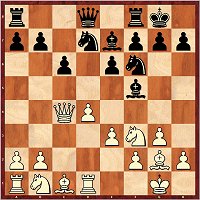 |
|
The position can also arise via the Queen’s Gambit Accepted, but
it is much more significant as a weapon against the Slav.
Holding back Nc3 involves a few subtleties, which Alexey Kuzmin explains in his article. |
Stohl: Queen's Gambit Accepted D27
1.d4 d5 2.c4 dxc4 3.Nf3 Nf6 4.e3 e6 5.Bxc4 c5 6.0-0 a6 7.Bb3
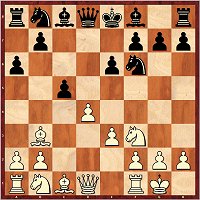 |
|
In the first part of his repertoire for White based on 7.Bb3,
Igor Stohl examines a few side-lines as well as the principled
7...b5, followed by 8.a4. After that 8...c4 appears to be
surprisingly strong. |
Krasenkow: Semi-Slav D46
1.d4 d5 2.c4 c6 3.Nf3 Nf6 4.Nc3 e6 5.e3 Nbd7 6.Qc2 Bd6 7.Bd3 0-0 8.0-0 dxc4 9.Bxc4 a6
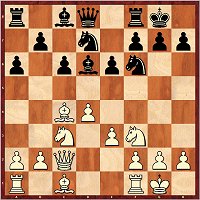 |
|
By playing 9...a6 instead of the major alternatives 9...b5 and
9...e5, Black keeps in reserve precisely those two moves and in
addition he is ready to play 9...c5 in many lines. The main
variation goes 10.Rd1 b5, and according to Krasenkow’s analysis White has no advantage. |
Schandorff: Queen's Gambit D52
1.d4 d5 2.c4 c6 3.Nf3 Nf6 4.Nc3 e6 5.Bg5 Nbd7 6.e3 Qa5 7.cxd5 Nxd5 8.Qd2 Bb4 9.Rc1 h6 10.Bh4 c5 11.Bc4
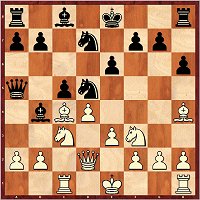 |
|
The variation with 10...c5 in the Cambridge Springs is
considered promising, see also the contribution from Rogozenco in
CBM 118. But in Wijk aan Zee Shirov twice had to admit defeat
against the so far little played 11.Bc4. |
Hazai/Lukacs: Queen's Gambit D56
1.d4 d5 2.c4 e6 3.Nf3 Nf6 4.Nc3 Be7 5.Bg5 0-0 6.e3 h6 7.Bh4 Ne4 8.Bxe7 Qxe7 9.Rc1 c6
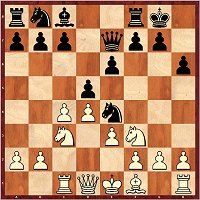 |
|
The Lasker Variation of the Orthodox Queen’s Gambit is
fashionable at the moment. Laszlo Hazai and Peter Lukacs examine 9.Rc1 which is almost always played nowadays, but White can hardly achieve anything against best play by Black. |
Avrukh: Catalan E05
1.d4 Nf6 2.c4 e6 3.g3 d5 4.Bg2 Be7 5.Nf3 0-0 6.0-0 dxc4 7.Qc2 a6 8.a4 Bd7 9.Qxc4 Bc6 10.Bf4
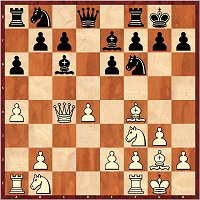 |
|
For a while, the move 8.a4 was unfashionable, but Boris Gelfand
has been showing a few new ideas in the variation with 10.Bf4 and since then players with Black have been endeavouring, so far in vain, to achieve complete equality. |
Marin: Bogo-Indian E11
1.d4 Nf6 2.c4 e6 3.Nf3 Bb4+ 4.Bd2 a5 5.Nc3 b6
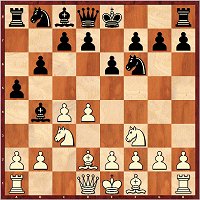 |
|
Mihail Marin continues his series on Bogo-Indian Variations
involving...a5 with an article on 5...b6, the move which is most
frequently played in the position. Black should be able to keep
things level with accurate play. |
Schipkov: King's Indian E83
1.d4 Nf6 2.c4 g6 3.Nc3 Bg7 4.e4 d6 5.f3 0-0 6.Be3 Nc6 7.Nge2 a6 8.Qd2 Bd7
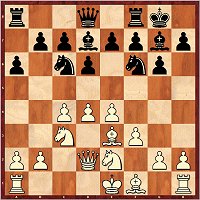 |
|
In an earlier article Boris Schipkov showed that after the old main move 8...Rb8 Black is faced with difficulties after 9.Rc1. Now the question is whether 8...Bd7 (intending 9.Rc1?! b5!) can represent a better alternative. |